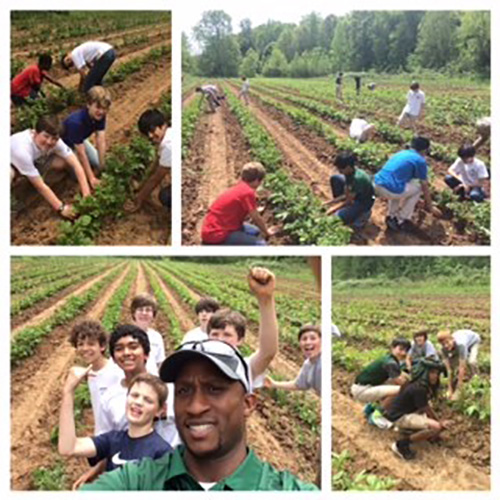Teaching "Food for Thought": A Middle School Interdisciplinary Unit
This Mini-Course provides a background for teaching the “Food for Thought” Middle School service-learning unit for the seventh grade. The "Food for Thought" unit covers how food is grown and harvested, the challenges of meeting the basic need of food, and the issue of food insecurity in the world. The multi-disciplinary 3-4 week curriculum is available for free on Learning to Give. At Westminster, the unit is taught in all subject-area classes and in advisory because the entire seventh grade participates.
Facilitators meet before the topics are introduced and share ideas and best practices for incorporating the unit’s themes into their curriculum. Advisement is used to continue and deepen the learning, to have guest speakers, and to provide time for off-campus, experiential exploration of the topic. Youth participate in service by working on a local farm and harvesting food. The unit also incorporates two service-learning projects, one in English and the other in Art. Through readings, research, site visits, local speakers, and service, learners are challenged to think about food in a new way and connect to their local community.
Mini-Course Author: Luana Nissan
After completing this course (about 45 minutes), the learner is prompted to take a bief quiz based on the content. Upon successful completion of this quiz, the learner may request a certificate suitable for a professional development portfolio, or as proof of .75 educational clock hours that can be used toward continuing education credit in most states. Please contact your State Department of Education or school district for specific information. Documentation of the completed courses and copies of the certificate are stored under "My Account" of the Learning to Give website where the learner may access (and print) them at any time.
In this learning module, you will
- gain a basic understanding about food insecurity,
- review best practices related to the growth and harvesting of food,
- describe how to advocate for a cause,
- identify how philanthropic action can be used to address food issues.
- learn about the core elements of the “Food for Thought” unit.
The interdisciplinary approach of "Food for Thought" helps the learner connect themes and skills to their life and community. It helps them see a real-life purpose in their learning. This section provides an overview of expectations and ways to connect to community resources in preparation for teaching the “Food for Thought” unit. The unit provides information and experiences to teach the following:
- understanding basics about food, including food insecurity, the relationship between poverty and nutrition, and how food is grown and harvested
- learning the stories of effective advocates
- developing skills of advocacy
This section provides a brief introduction to food and poverty themes, as well as sources to explore community gardens and farming. Some of the many topics that may be taught related to these themes include hunger, food insecurity, nutrition, cost of different foods, food choices, obesity, farming, food deserts, community gardens, farmers markets, federal hunger-relief programs, food pantries, and soup kitchens.
What is the purpose of advocacy, and how can advocacy be related to nonprofit organizations? We explore the different forms of advocacy in this section.
This quiz has four multiple-choice questions based on the mini-course "Teaching Food for Thought." If you answer 75 percent correctly, you will have the opportunity to download a personalized certificate. You may revisit the course and retake the quiz, if desired.
